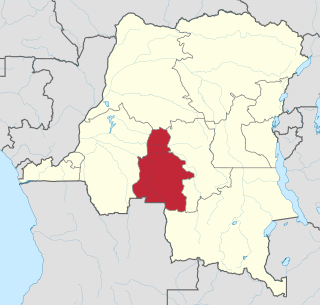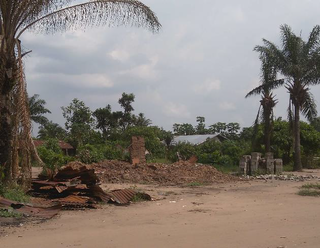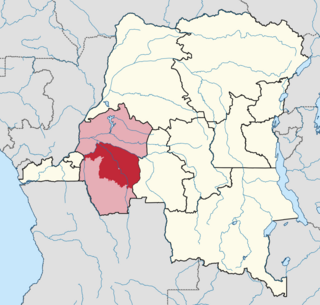
Bandundu is one of eleven former provinces of the Democratic Republic of the Congo. It bordered the provinces of Kinshasa and Bas-Congo to the west, Équateur to the north, and Kasai-Occidental to the east. The provincial capital is also called Bandundu.

Kasaï-Occidental was one of the eleven provinces of the Democratic Republic of the Congo between 1966 and 2015, when it was split into the Kasaï-Central and the Kasaï provinces.

Bangassou is a city in the south eastern Central African Republic, lying on the north bank of the Mbomou River. It has a population of 24,447 and is the capital of the Mbomou prefecture. It is known for its wildlife, market, and nearby Bangassou Airport and is linked by ferry to the Democratic Republic of Congo on the south bank. The city is also home to the Roman Catholic Diocese of Bangassou.
Owando is a town and a commune located in the central Republic of the Congo lying on the Kouyou River. It is the capital of Cuvette Department and of Owando District. It is home to a market and has an airport.
Bikoro is a market town in Équateur Province in the Democratic Republic of the Congo, lying on Lake Tumba, south of Mbandaka.
Kasongo, also known as Piani Kasongo, is a town and territory in the Maniema Province in the east of the Democratic Republic of the Congo.

Yumbi is a town and territory of Mai-Ndombe in the Democratic Republic of the Congo. It lies on the eastern bank of the Congo River between Bolobo and Lukolela. The town of Yumbi is the headquarters of Yumbi Territory and has a population of approximately 30,000.
Kasongo Lunda is a town and seat of Kasongo Lunda Territory, in the Kwango Province of the Democratic Republic of the Congo. The town lies near the border with Angola to the east, here defined by the Kwango River. As of 2012 the town was estimated to have a population of 23,820.

Haut-Uélé is one of the 21 provinces of the Democratic Republic of the Congo created in the 2015 repartitioning. Haut-Uélé, Bas-Uélé, Ituri, and Tshopo provinces are the result of the dismemberment of the former Orientale province. Haut-Uélé was formed from the Haut-Uélé district whose town of Isiro was elevated to capital city of the new province.

Tshopo is one of the 21 provinces of the Democratic Republic of the Congo created in the 2015 repartitioning. It is situated in the north central part of the country on the Tshopo River, for which it is named.
Idiofa Territory is an administrative area in the Kwilu Province of the Democratic Republic of the Congo (DRC). The capital is the town of Idiofa.
Gungu is a town in Kwilu Province, Democratic Republic of the Congo (DRC). It is the capital of Gungu Territory as well as Gungu Sector. The town lies west of the Kwilu River and is situated between the streams Lukunia in the south-east and Kitembo in the north-west. The estimated population as of 2012 was 23,893. Gungu is connected to the Congolese Road Network via the RP230 and RP231. Both roads are in a bad condition and the town is only reachable by 4x4 vehicles. As of July 2018, none of the roads in Gungu are paved and the large alleys are overgrown with grass. Only small paths remain that are regularly used by motorcycles. Water supply is provided by pumping water into the town from a nearby stream. There is an electricity network, but as of July 2018, it is not in operation, leaving the town with nearly no power.
Oshwe is a community in Mai-Ndombe province, Democratic Republic of the Congo (DRC). It is the headquarters of Oshwe territory. The town lies on the Lukenie River. The estimated population as of 2012 was 22,576. The town is served by Oshwe Airport at an elevation of 1,150 feet (350 m).
Kiri is a town in Mai-Ndombe Province, Democratic Republic of the Congo. It is the headquarters of Kiri Territory. As of 2012 the estimated population was 14,612. The town is served by a small airport, Basango Mboliasa Airport, at an elevation of 309 metres (1,013 ft).
Kiri Territory is an administrative region of Mai-Ndombe Province, Democratic Republic of the Congo. The headquarters is the town of Kiri.

Masi-Manimba is a town in Kwilu Province, Democratic Republic of the Congo, the headquarters of the Masi-Manimba Territory. As of 2012 the population was estimated to be 31,802.
The Bunda people or in the Democratic Republic of the Congo are an ethnic group that mostly live in Idiofa Territory of Kwilu Province. They speak the Mpuono language, spoken by an estimated 165,000 people as of 1972.

Kwilu District was a district of the Belgian Congo and the Democratic Republic of the Congo. It roughly corresponded to the present province of Kwilu.
The following is a timeline of the history of the city of Goma, Democratic Republic of the Congo.
Amadi is a town in the Bas-Uélé province of the Democratic Republic of the Congo (DRC).








